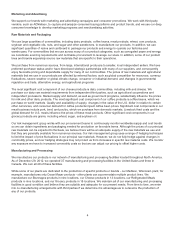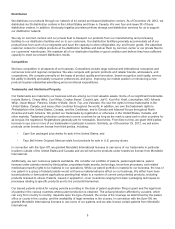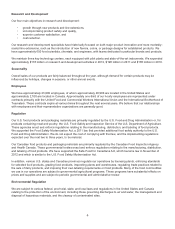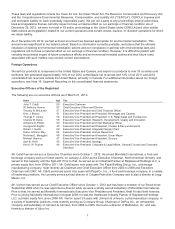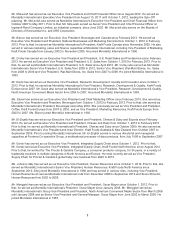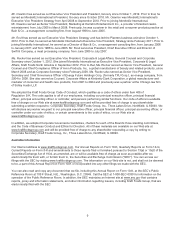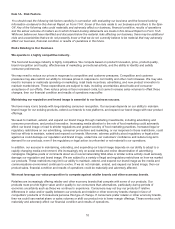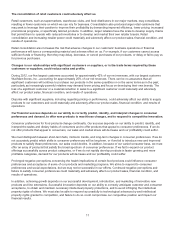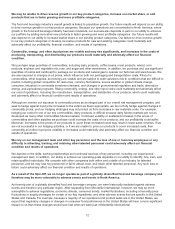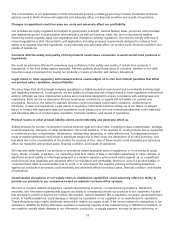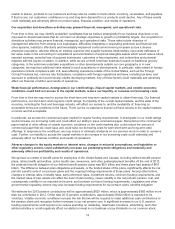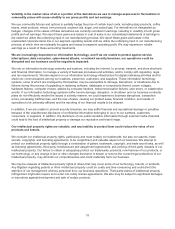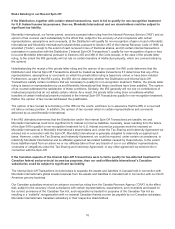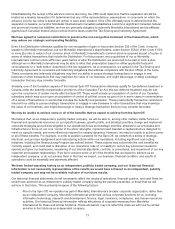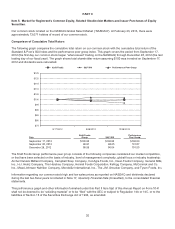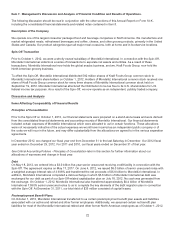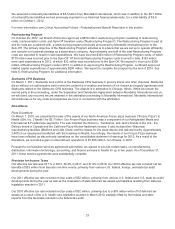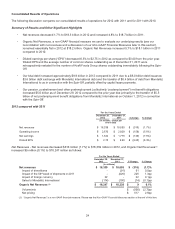Kraft 2012 Annual Report Download - page 16
Download and view the complete annual report
Please find page 16 of the 2012 Kraft annual report below. You can navigate through the pages in the report by either clicking on the pages listed below, or by using the keyword search tool below to find specific information within the annual report.unable to deliver, products to our customers and may also be unable to track orders, inventory, receivables, and payables.
If that occurs, our customers’ confidence in us and long-term demand for our products could decline. Any of these events
could materially and adversely affect our product sales, financial condition, and results of operations.
Our acquisition and divestiture activities may present financial, managerial, and operational risks.
From time to time, we may identify acquisition candidates that we believe strategically fit our business objectives or we
may seek to divest businesses that do not meet our strategic objectives or growth or profitability targets. Our acquisition or
divestiture activities may present financial, managerial, and operational risks. Those risks include diversion of
management attention from existing core businesses, difficulties integrating or separating personnel and financial and
other systems, inability to effectively and immediately implement control environment processes across a diverse
employee population, adverse effects on existing customer and supplier business relationships, inaccurate estimates of
fair value made in the accounting for acquisitions and amortization of acquired intangible assets which would reduce future
reported earnings, potential loss of acquired businesses’ customers or key employees, and indemnities and potential
disputes with the buyers or sellers. In addition, while we are a North American business focused on traditional grocery
categories, to the extent we undertake acquisitions or other developments outside our core geography or in new
categories, we may face additional risks related to such acquisitions or developments. In particular, risks related to foreign
operations include compliance with U.S. laws affecting operations outside of the United States, such as the Foreign
Corrupt Practices Act, currency rate fluctuations, compliance with foreign regulations and laws, including tax laws, and
exposure to politically and economically volatile developing markets. Any of these factors could materially and adversely
affect our financial condition and results of operations.
Weak financial performance, downgrades in our credit ratings, illiquid capital markets, and volatile economic
conditions could limit our access to the capital markets, reduce our liquidity, or increase our borrowing costs.
From time to time we may need to access the short-term and long-term capital markets to obtain financing. Our financial
performance, our short-term and long-term credit ratings, the liquidity of the overall capital markets, and the state of the
economy, including the food and beverage industry, will affect our access to, and the availability of, financing on
acceptable terms and conditions in the future. There can be no assurance that we will have access to the capital markets
on terms we find acceptable.
In particular, we access the commercial paper market for regular funding requirements. A downgrade in our credit ratings
would increase our borrowing costs and could affect our ability to issue commercial paper. Disruptions in the commercial
paper market or other effects of volatile economic conditions on the credit markets also could reduce the amount of
commercial paper that we could issue and could raise our borrowing costs for both short-term and long-term debt
offerings. In response to the conditions, we may reduce or eliminate dividends on our common stock in order to conserve
cash. Further, our inability to access the capital markets or an increase in our borrowing costs could materially and
adversely affect our financial condition and results of operations.
Adverse changes in the equity markets or interest rates, changes in actuarial assumptions, and legislative or
other regulatory actions could substantially increase our postemployment obligations and materially and
adversely affect our profitability and results of operations.
We sponsor a number of benefit plans for employees in the United States and Canada, including defined benefit pension
plans, retiree health and welfare, active health care, severance, and other postemployment benefits. At the end of 2012,
the projected benefit obligation of our defined benefit pension plans was $8.5 billion and these plans had assets of $6.6
billion. The difference between plan obligations and assets, or the funded status of the plans, significantly affects the net
periodic benefit costs of our pension plans and the ongoing funding requirements of those plans. Among other factors,
changes in interest rates, mortality rates, early retirement rates, investment returns, minimum funding requirements, and
the market value of plan assets can affect the level of plan funding, cause volatility in the net periodic pension cost, and
consequently volatility in our reported net income, and increase our future funding requirements. Legislative and other
governmental regulatory actions may also increase funding requirements for our pension plans’ benefits obligation.
We estimate the 2013 pension contributions will be approximately $625 million, which is approximately $583 million more
than we contributed in 2012. Of the total 2013 pension contributions, approximately $540 million is expected to be
voluntary. Volatile economic conditions increase the risk that we will be required to make additional cash contributions to
the pension plans and recognize further increases in our net pension cost. A significant increase in our U.S. pension
funding requirements could require us to reduce spending on marketing, retail trade incentives, advertising, and other
similar activities or could negatively affect our ability to invest in our business or pay dividends on our common stock.
14


